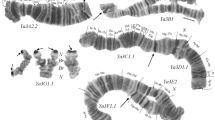Abstract
The larvae of the dipteran insect, Chironomus ramosus, found in Shillong, India, contain eleven (11) hemoglobin (Hb) components of which three are monomers (CI, CIV and CVI) and seven are dimers (CIII, CV, CVII, CVIII, CIX, CX and CXI), while one (CII) exists in both monomeric and dimeric states.
Four monomeric components were isolated, purified and partially characterized. The N-terminal amino acids were determined and showed glycine for CI and leucine for the other components (CII, CIV and CVI).
Three hemoglobin components were found to be present in all stages of larval development, except the first instar larvae. Some Hb components were synthesized in a particular instar, as revealed by electrophoretic appearance.
Electrophoretic mobilities of seven components and N-terminal amino acid residues of two components of Hb were similar in both Chironomus ramosus and Chironomus thummi thummi.
Similar content being viewed by others
References
Aschauer, H., T. Kleinschmidt, W. Steer & G. Braunitzer, 1982. Haemoglobin polymorphism in Chironomus (Dipt.): primary structure, allergenic determinants and monomer-dimer equilibrium. De Gruyter & Co., Berlin. Chemistry of Peptides and Proteins 1: 61–70.
Bergtrom, G., H. Laufer & R. Roggers, 1976. Fat body — a site of hemoglobin synthesis in Chironomus thummi (Dipt.). J. Cell. Biol. 69: 264–274.
Braun, V. V., R. R. Crichton & G. Braunitzer, 1968. Über monomere und dimere Insektenhamoglobine (Chironomus thummi). HoppeSeyler's Z. Physiol. Chem. 349 S: 197–210.
Braunitzer, G. & V. Braun, 1965. Zur Phylogenie des Hämoglobinmoleküls Untersuchungen an Insekten Hamoglobinen (Chironomus thummi). Z. Physiol. 340: 88–91.
Clever, U., 1964. Genaktivitäten und ihre Kontrolle in der tierischen Entwicklung. Naturwissenschaften 19: 449–59.
Goodman, M., G. Braunitzer, T. Kleinschmidt & H. Aschauer, 1983. Analysis of a protein polymorphism: Evolution of monomeric and homodimeric hemoglobins (Erythrocruorins) of Chironomus thummi thummi (Insecta, Diptera). Hoppe-Seyler's Z. Physiol. Chem. 364: 205–218.
Hubber, R., O. Epp & H. Formanek, 1969. The environment of the heam group of erythrocrurin (Chironomus thummi).J. Mol. Biol. 42: 591–594.
Ingram, V. M., 1963. The Hemoglobins in Genetics and Evolution. CUP, New York.
Kleinschmidt, T., H. G. Keyl & G. Braunitzer, 1989. Comparison of insect hemoglobins (enythrocruorins) from Chironotnus thummi thummi and Chironomus thummi piger (Diptera). The primary structure of the monomeric hemoglobin CTP III. Biol. Chem. Hoppe-Seyler 370: 839–845.
Kleinschmidt, T., H. Aschauer, W. Steer, J. Pfletschinger & G. Braunitzer, 1981. Polymorphism of hemoglobins (erythrocruorins) of Chironnmus (Insecta): primary structure and monomeric dimeric equilibrium. In Lamy, J. & J. Lamy (eds), Invertebrate oxygen binding proteins. Marcel Dekker, New York: 267–273.
Laufer, H. & J. Poluhowich, 1971. A factor controlling the concentration of hemoglobin in Chimnomus during metamorphosis. Limnologica 8: 125–126.
Laufer, H., G. Bergtrom & R. Rogers, 1976. Stage and tissue specific hemoglobin synthesis in an invertebrate. In Kurstak, E. & K. Maramorosch (eds), Invertebrate Tissue Culture: Applications in Medicine, Biology and Agriculture. Academic Press, New York: 227–240.
Manwell, C., 1966. Starch gel electrophoresis of the multiple hemoglobins of small and large larval Chironomus — a developmental hemoglobin sequence in an invertebrate. J. Embryol. exp. Morph. 16: 259–270.
Needleman, S. B. (ed.), 1975. Protein sequence determination. Springer Verlag, Berlin.
Thompson, P. E. & D. S. English, 1966. Multiplicity of hemoglobins in the genus Chironomus (Tendipes). Science 152: 75–76.
Tichy, H., T. Kleinschmidt & G. Braunitzer, 1981. Studies on the evolutionary relationship between hemoglobins of Chironnmus pallidivittatus and C. tentans: Isolation and immunological analysis of monomeric and dimeric hemoglobins. J. Mol. Evol. 18: 9–14.
Weber, R. E., G. Braunitzer & T. Kleinschmidt, 1985. Functional multiplicity and structural correlation in the hemoglobin system of larvae of Chironnmus thummi thummi (Insecta, Diptera) Hb components CTT I, CTT II, CTT III, CTT IV, CTT VI, CTT VII B, CTT IX & CTT X. Comp. Biochem. Physiol. 80 B: 747–753.
Walshe, B. M., 1950. The function of haemoglobin in Chironomus plumosus under natural conditions. J. exp. Biol. 27: 73–95.
Author information
Authors and Affiliations
Rights and permissions
About this article
Cite this article
Das, R., Handique, R. Hemoglobin in Chironomus ramosus (Insecta, Diptera): an electrophoretic study of polymorphism, developmental sequence and interspecific relationship. Hydrobiologia 318, 43–50 (1996). https://doi.org/10.1007/BF00014130
Received:
Revised:
Accepted:
Issue Date:
DOI: https://doi.org/10.1007/BF00014130



